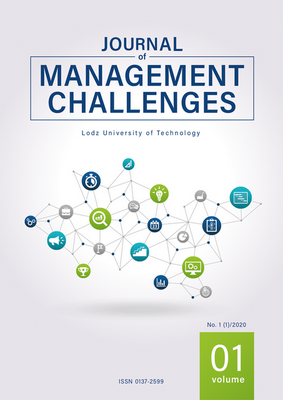Abstrakt
Innovative sectors of high technology are considered as one of the most important elements of the modern economy. The biotechnology industry perfectly fulfills the criteria of belonging to sectors of this type, and by some researchers [1] its development is considered indispensable for the functioning of modern economy. In technologically advanced industries, progress is impossible without access to knowledge and innovation, the most important source of which are research and development (R&D) institutions – both parts of companies and state research and educational entities (higher education institutions).
Bibliografia
Cooke P., The accelerating evolution of biotech clusters, “European Planning Studies” 2004, vol. 12, no. 7, ss. 915-920.
Eliasson G., Industrial policy, competence blocs and the role of science in economic development, “Journal of Evolutionary Economics” 2000, vol. 10, ss. 217-241.
Landry R., Amara N., Rherrad I., Why are some university researchers more likely to create spin-offs than others? Evidence from Canadian universities,“Research Policy” 2006, vol. 35, ss. 1599-1615.
Cieślik J., (2012), Kształcenie w zakresie przedsiębiorczości na poziomie akademickim, Wyższa Szkoła Przedsiębiorczości i Zarządzania im. Leona Koźmińskiego, http://www.cieslik.edu.pl, (dostęp: 24.10.2013).
Lawton-Smith H., The Biotechnology Industry in Oxfordshire: Enterprise and Innovation, “European Planning Studies” 2004, Carfax Publishing, vol. 12, no. 7, ss. 985-1001.
Klimek J., Klimek S., (2010), Przedsiębiorczość bez tajemnic, Wydawnictwo Adam Marszałek, Toruń.
West M., (2000), Rozwijanie kreatywności wewnątrz organizacji, Wydawnictwo Naukowe PWN, Warszawa.
Balcerzak A., Moszyński M., (red. nauk.), (2011), Spin off, spin out jako instrument budowania przedsiębiorczości akademickiej oraz stymulowania innowacyjności regionu, Polskie Towarzystwo Ekonomiczne – Oddział w Toruniu, Toruń.
Cieślik J., Guliński J., Matusiak K., Skala-Poźniak A., (2011), Edukacja dla przedsiębiorczości akademickiej, PARP, Skuteczne Otoczenie Innowacyjnego Biznesu, Poznań-Warszawa,.
Matusiak K. (red.), (2005), Innowacje i transfer technologii – słownik pojęć, Polska Agencja Rozwoju Przedsiębiorczości, Warszawa.
Lawton-Smith H., Bagchi-Sen S., Triple helix and regional development: a perspective from the Oxfordshire in the UK, “Technology Analysis & Strategic Development” 2010, vol. 22, no.7, Routledge, London, ss. 805-818.
Shane S., (2004), Academic Entrepreneurship: University Spinoffs and Wealth Creation, Edward Elgar Publishing, Cheltenham, UK, Northampton, MA, USA.
Shane S., Cable D., Network ties, reputation and the financing of new ventures, “Management Science” 2002 , vol. 48, no. 3.
Abramovsky L., Simpson H., Geographic proximity and firm-university innovation linkages: evidence from Great Britain, “Journal of Economic Geography” 2011, vol. 11, ss. 949-977.
Decarolis D.M., Deeds D.L., The Impact of Stocks and Flows of Organizational Knowledge on Firm Performance: An Empirical Investigation of the Biotechnology Industry, “Strategic Management Journal” 1999, vol. 20, no. 10, , ss. 953-968.
Ter Wal A.L.J., Boschma R.A., Co-evolution of firms, industries and networks in space, “Papers in Evolutionary Economic Geography” 2007, vol. 7, no. 7, Utrecht University, Utrecht.
Lawton-Smith H., Ho K., Measuring the performance of Oxford University, Oxford Brookes University and the government laboratories’ spin-off companies, “Research Policy” 2006, vol. 35, ss. 1554 1568.
Sorenson O., Stuart T., Syndication networks and the spatial distribution of venture capital investments, “American Journal of Sociology” 2001, vol. 106, no. 6, ss. 1546-1588.
Coenen L., Moodysson J., Asheim B.T., Nodes, Networks and Proximities: On the Knowledge Dynamics of the Medicon Valley Biotech Cluster, “European Planning Studies” 2004, vol. 12, no. 7, ss. 1003-1018.
Dubin A. (red.), (2007), Stan i kierunki rozwoju biogospodarki, Ministerstwo Nauki i Szkolnictwa Wyższego, Warszawa.
EuropaBio – advocating and educating on biotechnology. The European Association for Bio industries, http://www.europabio.org/eu_index.htm,(dostęp: 13.01.2019).
Go Global! Raport o innowacyjności polskiego sektora farmaceutyczno-medycznego, „Polish Pharma”, 2018, http://www.paiz.gov.pl/files/?id_plik=19607 (dostęp: 12.01.2019).
Ordon M., The Innovation Push, “Warsaw Business Journal” 2012, vol. 18, no. 49.
CSO: Central Statistical Office, Activity of non-financial enterprises in 2011, Warsaw 2016.
CSO: Central Statistical Office, Quarterly information on the labour market, Warsaw 2016.
Shimasaki C., (2009), The Business of Bioscience. What Goes into Making a Biotechnology Product, Springer, London-New York.
EuropaBio. Agricultural Biotech. The European Association for Bioindustries, http://www.europabio.org/green_biotech/GBE_about.htm, (dostęp: 13.01.2019).
Orłowski W., Komercjalizacja badań naukowych w Polsce. Bariery i możliwości ich przełamania, Raport PwC, http://lifescience.pl/raporty/raport-komercjalizacja-badan-naukowych-w-polsce-bariery-i-mozliwosci-ich-przelamania, 2013 (dostęp: 24.04.2014).
Broker innowacji: nowy zawód ma pomóc w szukaniu patentów, https://forsal.pl/, data publikacji: 19.09.2013 (dostęp: 13.01.2019).

